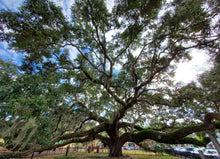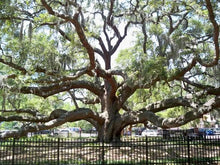The Live Oak (Quercus virginiana) is an evergreen, long-lived powerhouse tree with an impressive live span of 300 or more years. It grows between 40-80 feet tall and 40-100 feet wide with its roots expanding 3 times the width of the canopy. The roots are important for soil stabilization, sequestering carbon and management of our important watersheds. This keystone species supports over 500 species of wildlife. If you can plant only one plant and have some space, plant an Oak! Live Oaks are wind pollinated and have blooms that are not obvious in the springtime. Hummingbirds are attracted to the flowers. Acorns produced by oaks are a significant food source for birds, squirrels and other wildlife and 1 tree can produce upwards of 3 million acorns during its lifetime. These trees can tolerate occasional inundation of salt water and they are also tolerant of salty wind and spray.
Its leaves are an extremely important food sources to many species of butterfly and moth caterpillars as their host plant including Mourning Cloak, Horaces duskywing, Edwards Hairstreak, White M Hairstreak, Juevenal's duskywing, Cecropia moth, Polyphemus moth, Rosy Maple moth, Clynene moth and Imperial moth to name a few. The fallen leaves are also very important to wildlife! The Red-banded hairstreak uses dead oak leaves as its host plant. Native bees use dead leaves as a home as well as several other insects. The fallen oak leaves also provide moisture barriers that are far better than other mulches and also put nutrients back into the soil as they break down over time.
The caterpillars provide a massive food source for nesting birds that make the oaks their home. It is known that it takes 6,000-9,000 caterpillars to fledge one nest of baby birds and oaks do the best job of supporting many species of birds that rely on this food source and shelter.
Oaks are known to be hosts to epiphytes such as ball moss, Tillandsia recurvata and Spanish moss, T. usneoides), ferns (resurrection fern, Pleopeltis polypodioides and orchids including butterfly orchid (Encyclia tampensis).
If you are interested in providing host plants for a wide variety of months and butterflies, make sure your landscape includes one or more species of native oaks. Even if butterflies do not use the oak as their host, they often roost overnight in the trees. Planting an oak is an investment in the future of our ecosystem that will yield dividends for years to come.
If you want to learn more about Oaks, we recommend Dr. Douglas Tallamy's book, The Nature of Oaks to truly understand all these trees have to offer. This is available in our gift shop for purchase.




